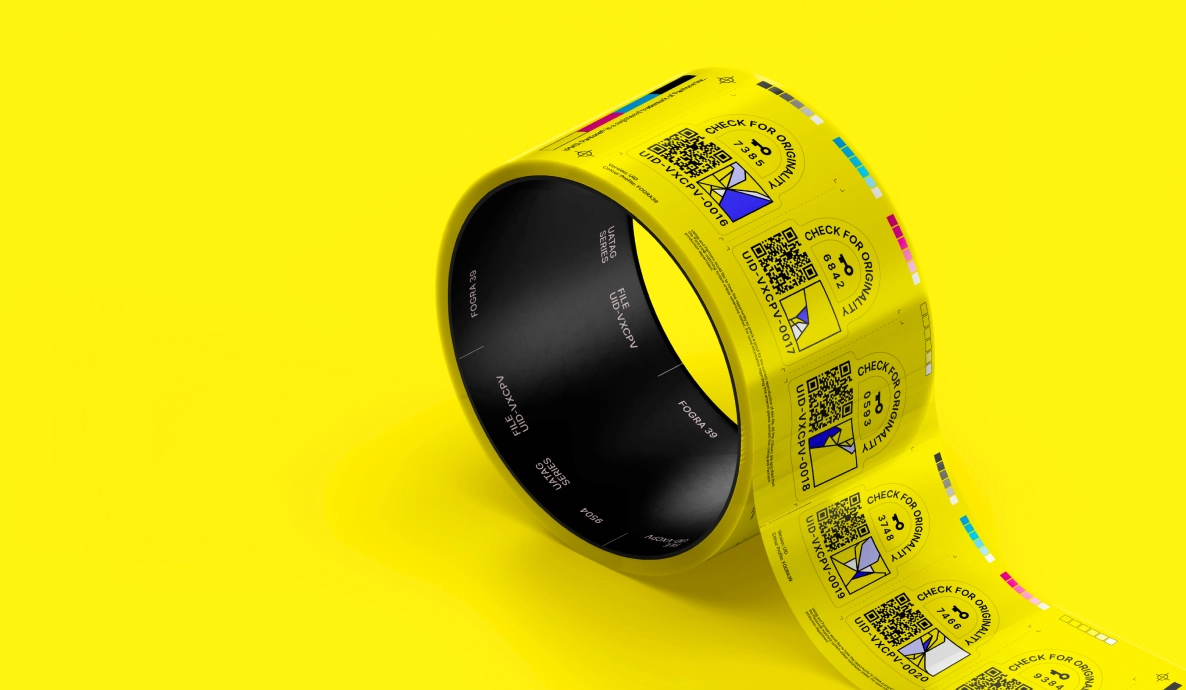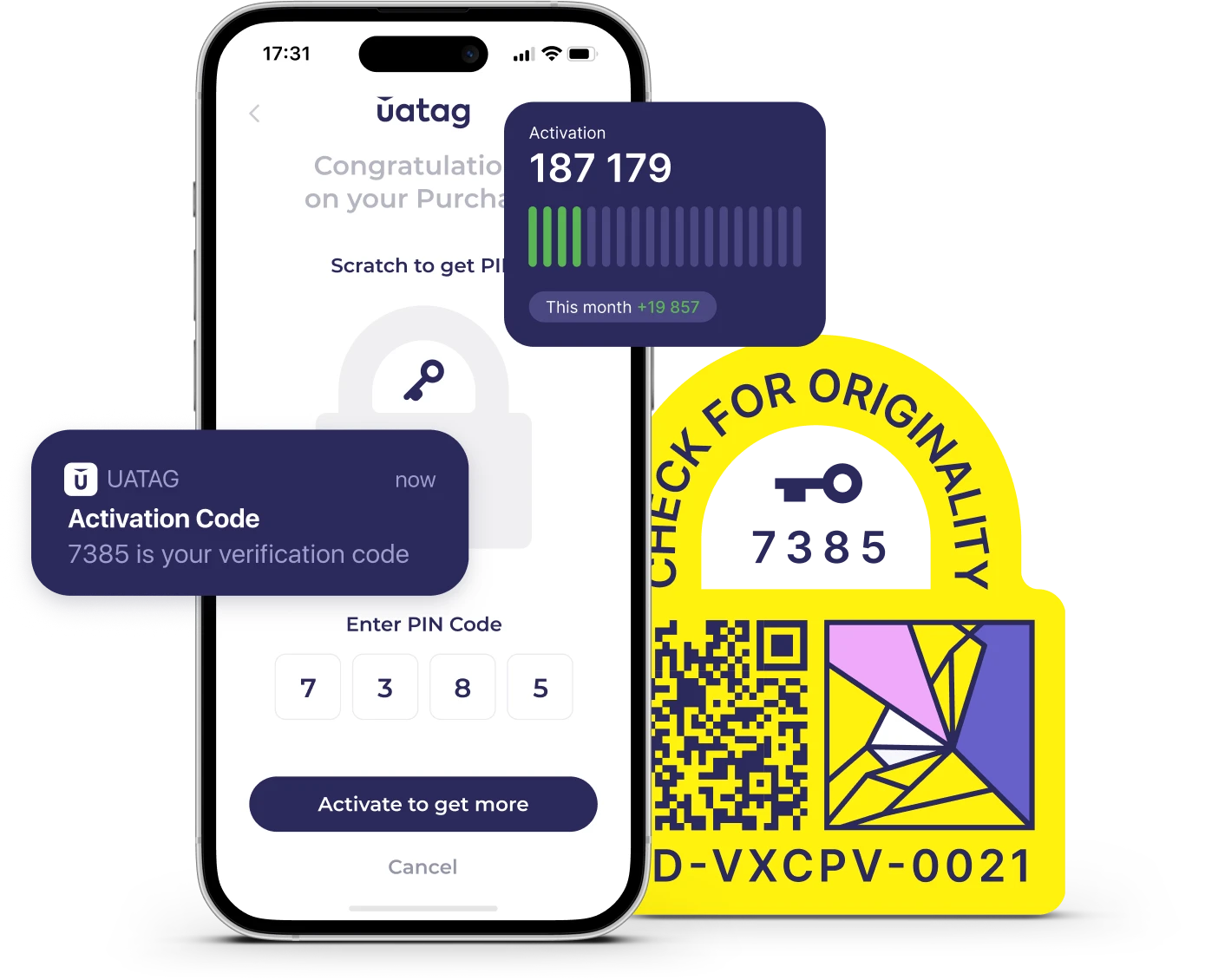Uatag — a unique anti-counterfeiting solution
The problem of counterfeiting is one of the most acute and urgent in business. Every year, the global market faces enormous losses due to the spread of counterfeit products. This applies not only to luxury goods such as clothing, footwear or accessories, but also to vital products, including medicines, auto parts and even foodstuffs. Experts estimate that losses from counterfeits amount to billions of dollars, and the negative impact on the reputation of brands can be even more devastating.
Unoriginal goods cause serious damage not only to manufacturers but also to end consumers. People, faced with low-quality or unsafe products, lose trust in the brands they previously preferred. Even a single case of purchasing counterfeit goods can lead to a loss of loyalty, which in a highly competitive market has disastrous consequences for business.
Uatag — a unique anti-counterfeiting solution
Uatag technology is a revolutionary anti-counterfeiting solution, offering a unique approach that combines cutting-edge technology with innovative design. The basic idea behind Uatag is to create individual tags for each product, which significantly increases the level of product protection and minimizes the risk of counterfeiting.
One of the key elements of the Uatag technology is the use of a unique QR code, which is applied to each tag. This QR code serves as a kind of «passport» of the product, which can be easily scanned with the help of a smartphone or other device. When scanning the code, the consumer is redirected to a special online platform where he can check the authenticity of the product. This provides not only quick and easy product verification, but also creates a reliable channel of communication between the manufacturer and the consumer.
One of the features of this technology is the use of a unique pattern that is applied to each tag. This pattern, like a fingerprint, is completely unique and different for each product. Even without the use of any device, this pattern can be identified visually, which provides an additional level of protection.
In addition, each Uatag tag contains a cryptographically signed unique serial number, making it virtually impossible to counterfeit. This serial number allows for independent product verification, ensuring full traceability of the product at all stages of its lifecycle — from production to the end consumer.
Founding history and inspiration
The idea of creating unique Uatag tags originated in 2017 thanks to Taras Rodtsevich, the founder of the company. Seeking to solve one of the most acute problems of the modern market — product counterfeiting, Taras decided to create a system that would provide each product with a «unique imprint». The inspiration for this project was the idea that every product, like every person, should be unique and easily recognizable. The basic concept was the idea of creating a tag that would not only identify the product, but would also be impossible to counterfeit due to its unique nature. This is how Uatag — a system based on the idea of individualized product protection – came into being, which was a real breakthrough in the field of anti-counterfeiting.

Technological aspects
One of the key technical solutions is the use of glass shards to create unique tags. These shards form a unique pattern that becomes a fingerprint for each product. This pattern is impossible to reproduce, making each tag absolutely unique and copy-proof.
How the Uatag system works
Uatag is a complete solution that starts with the creation of unique tags and continues right up to the point where the consumer scans the tag, providing the manufacturer with valuable data to analyze. Let’s take a step-by-step look at how the system works:
- Step 1 is the production of the product. The client, the product manufacturer, manufactures its products. Regardless of the type and category of product, be it clothing, electronics or cosmetics, each item can be protected with a unique Uatag tag.
- Step 2 is generating a unique Uatag tag. Once the product is manufactured, the company generates a unique tag for each individual product. It consists of three key elements:
- QR code;
- a unique pattern;
- cryptographically signed serial number.
- Step 3 is applying the tag to the product. The generated unique tag is attached to the product. Depending on the type of product and its packaging, the tag can be applied directly to the packaging, attached as a sticker or integrated into the product design.
- Step 4 is selling and buying the product. Once the tag is applied, the product goes on sale. When a consumer buys the product, he gets an opportunity to check its authenticity with the help of Uatag technology. To do this, it is enough to scan a QR code on the tag with the help of a smartphone.
- Step 5 is tag scanning and authentication. When the QR code is scanned, the consumer is redirected to the Uatag online platform where they are provided with information about the product and its authenticity. In addition, the system may request the entry of a PIN or one-time password (OTP), which adds an extra layer of security.
- Step 6 is data collection and analysis. Once a tag is scanned, the Uatag system automatically collects data about the consumer’s interaction with the product. This information includes the time and location of the scan, user demographics, and other important parameters that help the manufacturer better understand its audience and improve marketing strategies. All this data is available to the customer through the Uatag analytics dashboard.
How Uatag works for end users
The product authentication process involves a few simple steps:
- The first step is to scan the QR code located on the product tag. Using your smartphone, you need to point your camera at the QR code and the system will automatically redirect to the website. You will see an image of the unique crack pattern on the glass that was generated for your specific tag, as well as a serial number stored in the blockchain. This number is an additional assurance that the information has not been altered or tampered with.
- After scanning, your smartphone screen will display detailed information about the product, including its type, manufacturer, transaction time and geographic location (geotag). This information should be fully consistent with your expectations and with the data that appears on the product packaging. If you notice discrepancies, it may indicate that the product is counterfeit.
- Comparing the crack pattern on the glass on your tag with the image presented on your smartphone screen. Since each pattern is unique and cannot be reproduced, a pattern match is a reliable confirmation of the authenticity of the product. If the pictures on the tag and on the screen are identical, it means that the product is original.
- After successful completion of the authentication, you can activate the product. To do so, you need to peel off the protective coating on the label, which hides the PIN code to be entered on the website. Product activation is the final step that not only confirms your purchase, but also gives you access to additional services such as loyalty programs and personalized offers.
All product authentication services are completely free for end users. This means that you can easily and cost-effectively verify the authenticity of your purchase using a convenient and secure service from Uatag.
Uatag’s business benefits
Let’s take a look at the main benefits that Uatag offers companies:
- Product authentication. One of the main advantages of Uatag is the ability to securely authenticate products. Each tag contains a unique QR code and a unique pattern, making each product unique.
- Increasing consumer trust and loyalty. Uatag creates a strong bond between brand and consumer. People appreciate being able to verify the authenticity of products, especially in a market saturated with counterfeits.
- Data collection for market analysis. The system captures every scan of a QR code, providing manufacturers with information about the time, place and circumstances of product usage. Using this data, companies can develop more accurate marketing strategies and effectively customize advertising campaigns.
- Improved customer engagement. Personalized promotions, discounts and loyalty programs can be offered through the system to encourage repeat purchases and strengthen customer relationships. The ability to communicate directly with consumers through Uatag allows brands to respond quickly to feedback, improving the customer experience and maintaining high levels of customer satisfaction.
- Increased competitiveness. In a highly competitive market, the ability to offer consumers an extra level of security and confidence in product quality will be a decisive factor in brand selection.
Uatag’s role in building consumer confidence
Uatag’s development prospects include deep integration with other digital solutions such as blockchain, the Internet of Things (IoT) and artificial intelligence (AI). Using blockchain to record data about each tag scan, gives even greater transparency and the inability to falsify product information.
More and more consumers are paying attention to the origin of goods, their production conditions and environmental impact. Uatag can be a key tool for creating Digital Product Passport for products, which will contain full information about the origin, composition and environmental footprint of a product.

In this way, Uatag not only solves current product protection challenges, but also opens up new perspectives for future product management.

